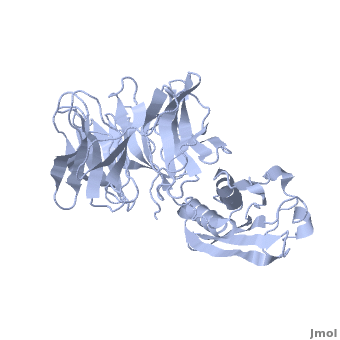Structure
TolB is a 44-kDa periplasmic protein partially associated with the outer membrane[1]. It has two domains: an N-terminal α/β domain and a C-terminal six-bladed β-propeller (to which Pal and Colicin E9 bind)[2]. The β-propeller has a latching or ‘Velco’ strand which joins the first and last of the six blades, and is positioned in the domain-domain interface. When Pal binds to the C-terminus of TolB, the latching strand moves away from the interface and carries with it a proline residue. The movement of the latching strand opens up a canyon that would normally be buried between the N- and C-terminal domains of TolB. This canyon can now be used as a binding site for the N-terminal of TolB, which forms a helical half-turn and a β-sheet against the canyon. For additional details see Tol.
Function
The distal N-terminal 12 residues of TolB has two conformational states which are governed by protein-protein interactions with the β -propeller and results in the binding of TolA in the inner membrane[2].
TolB has been shown to be essential for the function of the Tol system in Escherichia coli[2] by generating an allosteric signal based on a conformational switch in the β-propeller region. TolB has also been shown to interact with the porins of Escherichia coli, in particular OmpF, OmpC, PhoE and LamB, but not OmpA or any of their denatured counterparts. It has been proposed that the whole Tol complex plays a role in this association, although "tol" mutants do not prevent this assembly completely therefore the Tol system may be involved kinetically, not directly[3].
The TolB-Pal Complex
The TolB-Pal complex is involved in maintaining the outer membrane integrity. Upon binding, TolB and Pal undergo a conformational change , the result of which is crucial for further interactions with other proteins[4]. This complex is parasitised by protein antibiotics and disrupted in order to trigger the translocation of the toxin across the outer membrane (see Colicin for further information)[2].
To study the interaction of TolB with Pal, two studies were carried out[1]: TolBBep (tagging TolB for immunoprecipitation), which allows the associated proteins to remain in contact with TolB, and in vivo cross-linking experiments with formaldehyde. Immunoprecipitation gave the result that Pal co-precipitates with TolBBep, while the cross-linking showed that in the present of Pal, the two products migrated close to each other, but in the absence of Pal, neither band was present, demonstrating an interaction between the two. These two experiments showed that TolB directly interacts with Pal, and that this interaction is responsible for maintaining the association of TolB with the membrane.
|
|
| E. coli TolB (cyan) complex with peptidoglycan-associated lipoprotein (gold), acetate, sulfate and glycerol, (PDB code = 2hgs)
|
| Ligands:
| , ,
|
| Gene:
| tolB (Escherichia coli), pal, excC (Escherichia coli)
|
| Related:
| 1c5k, 1oap, 1crz
|
| Structural annotation:
|
| Resources:
| InterPro : Ipr011044, Ipr014167, Ipr011042, Ipr007195, Ipr011659, Ipr006664, Ipr006690, Ipr006665, Ipr014169
Pfam : PF04052, PF07676, PF00691
UniProt : P0A855, P0A912
|
|
|
|
|
|
| Resources:
| FirstGlance, OCA, RCSB, PDBsum
|
| Coordinates:
| save as pdb, mmCIF, xml
|


